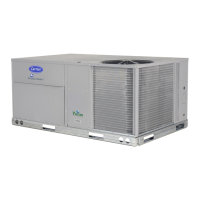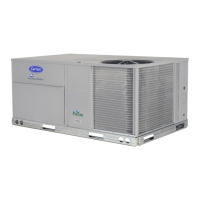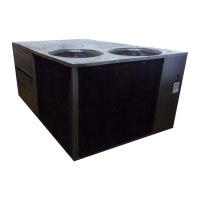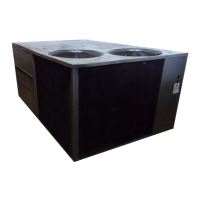19
expire before another stage can be added or a stage can be
subtracted. If at any time the Supply--Air Temperature (SAT) falls
below the Minimum Supply Air Temperature Upper Level
(ConfigurationCOOLSATSAT.U), the requested stages
will not be allowed to increase. If at any time the SAT falls below
the Minimum Supply Air Temperature Lower Level
(ConfigurationCOOLSATSAT.L), the requested stages will
be reduced by one without honoring C.DEC. If SAT.L and SAT.U
are configured so that they are close together, the last stage of
compressor might cycle rapidly, slowed only by its minimum on
and off--time requirements.
Compressor Control
The compressor control works hand and hand with the staging
control. As the staging control requests stages, the compressor
control determines what actual compressors are available or
running and tries to provide stages for what is requested. The
availability of a compressor depends on time guards, circuit
diagnostics, outdoor temperature, and the unit size.
The Number of Circuits (ConfigurationCOOLN.CIR)
configuration tells the control how many compressors are installed
on the unit. The Circuit A Lockout Temp
(ConfigurationCOOLCIR.ACA.LO) and Circuit B
Lockout Temp (ConfigurationCOOLCIR.BCB.LO)
configurations set the outdoor temperature in which the respective
compressor is allowed to run down to. Timeguard A (Run
StatusCOOLCIR.ATG.A) and Timeguard B (Run
StatusCOOLCIR.BTG.B) display the time a respective
compressor has before it is available for use. Individual circuit
diagnostic tests are performed during operation which may or may
not allow a compressor to be used. The available stages at any
given time are displayed as Available Compressors (Run
StatusCOOL AVL.C). The actual compressors running at
any given time are displayed as Actual Cooling Stages
(Operating ModesCOOLACT.C). Compressor A (Run
StatusCOOLCIR.A CMP.A)andCompressorB(Run
StatusCOOLCIR.B CMP.B) are displayed on when the
respective compressor is running.
There are time guards to protect the compressors. Compressor Min
On Time (ConfigurationCOOLMRT.C)andCompressorMin
Off Time (ConfigurationCOOL
MOT.C) apply before a
compressor can be turned back on or turned off.
Outdoor Fan Control
Outdoor fans are controlled electromechanically, not directly by the
control system. Refer to specific unit wiring diagram and or service
manual for details on how the outdoor fans operate. In general, the
outdoor fan is energized with compressor A or may have partial
fans operate with compressor B. Humidi--MiZert units will have a
Motormaster
R
control on some or all fans.
Dehumidification Control
On units equipped with a VFD, a simple dehumidification function
is available if not equipped with the Humidi-MiZert option.
Dehumidification operation requires installation and configuration
of either a space relative humidity sensor or a relative humidity
switch input. Dehumidification is a cooling mode function. This
dehum control is set by the configuration Dehum Control no
Reheat (Configuration COOL DHUM). Dehum Control is
factory defaulted to Disable which means that any dehum demand
is ignored.
IMPORTANT: The HUM terminal on the field connection board
is not wired and requires an isolation relay with gold plated
contacts to wire to MBB J9-5 and 6. The RH sensor input requires
the ECB to be installed if not already.
When enabled, Dehum control will monitor the dehumidification
demand, cooling demand, and heating demand. If a cooling call or
heating call is present, the dehumidification routine will be prevented
or cancelled. When just a dehumidification demand is present, the
control will request a Reheat2 Stage, Requested Reheat2 Stages = 1
(Operating Modes COOL HMZRREQ.R) and run the indoor
fan at Fan Speed - Reheat2 (Configuration I.FAN FS.RH).
During this condition the Dehumidification Active? (Operating
Modes COOL ACT.D) status point will be yes. This will
continue until the dehumidification demand is satisfied or a cooling or
heating call is activated.
Heating Operation
The 48/50HC unit’s heating operation consists of: demand, mode
determination, staging request to satisfy the demand, and handling a
request with the unit’s resources. These resources can be gas heat or
electric heat. This section covers both gas heat units and electric heat
units. The Type of Heat Installed (ConfigurationHEATHT.TY)
configuration will be factory set to 1 for gas units, 2 for electric heat
units with heaters installed, and 0 for electric heat units without heat
installed. The unit enters a heating mode based on a demand, decides
how to satisfy the demand, executes its plan, and then leaves the
heating mode.
Heating Mode Control
The heating HVAC mode (Run StatusMODEHVAC=4),
represents both types of heating (gas or electric) under all types of
control. For the unit to be allowed to enter the heat mode, heat
must be enabled (HT.TY = 1 or 2), and the Outdoor Air
Temperature (TemperaturesAIR.TOAT) must be less than the
Heating Lockout Temp (ConfigurationHEATHT.LO). Heat
OAT Lockout (Run StatusMODEH.LOC) displays when
heat is locked out on outdoor temperature and therefore can not
allow heat mode. The control will display if it is ok to select the
heating mode (Operating ModesHEAT OK.HT= Yes).
Thermostat Control
For the unit to enter heating mode, three additional things must be
true: the indoor fan must be ok to use, the mode changeover time
guard must be expired, and there must be a heating demand (W1,
W2). The unit will remain in heating until the heating demand is
dropped or if any of the above conditions turn false. The heating
mode can not officially end until all heat stages are off and the IGC
fan request is dropped (on gas units).
Space Sensor Control
For the unit to enter heating mode, five additional things must be
true: the indoor fan must be ok to use, the mode changeover time
guard must be expired, the unit must have a valid space
temperature, the W1 jumper must be installed, and there must be a
heating demand. The unit will remain in heating for at least one
minute and until the heat demand drops below --0.5_Forifanyof
the above conditions turn false. The heating mode can not
officially end until all heat stages are off and the IGC fan request is
dropped (on gas units without Humidi--MiZer).
Supply--Air Temperature Sensor (SAT)
The SAT Heat Mode Sensing (Configuration
HEATSATSAT.H) informs the unit if the supply air sensor
has been relocated downstream of the heat section. This
configuration affects the Supply Air Temperature (Temperatures
AIR.TSAT) value displayed as listed below.
When SAT.H = DSBL, the Supply Air Temperature (Temperatures
AIR.TSAT) value on the Scrolling Marquee and the CCN
tables will be forced to zero when heat outputs turn ON or OFF
and for 5 minutes after. The default Supply Air Temperature
location is at the fan inlet, upstream of the heat section.
When SAT.H = ENBL, the Supply Air Temperature (Temperatures
AIR.TSAT) sensor reading is displayed at the Scrolling
Marquee and the CCN tables during heating mode. This setting
should only be used if the original SAT sensor wires are removed
from the Main Base Board (MBB) and replaced by an accessory
SAT sensor located in the supply duct downstream of the
heat section.
ComfortLINK v1.X

